{ DOWNLOAD AS PDF }
ABOUT AUTHORS:
Niyati Borkar*1, SS Saurabh2, KS Rathore3, Ashlesha Pandit1, KR Khandelwal1
1JSPM’s Rajarshi Shahu College of Pharmacy and Research, Tathwade, Pune, India
2Lachoo Memorial College of Science & Technology, Pharmacy Wing, Jodhpur (Raj.), India
3BN Institute of Pharmaceutical Sciences, Udaipur (Raj.), India
niyatiborkar@yahoo.in
ABSTRACT
The concept of nutraceutical a evidence based medicines was started from a survey held in United Kingdom, Germany and France which concluded that diet is rated more highly by consumers than exercise or hereditary factors for achieving good health. Nutraceutical, a portmanteau of the words “nutrition” and “pharmaceutical”, is a food or food product that reportedly provides health and medical benefits, including the prevention and treatment of disease. Nutraceutical is a term that does not easily fall into the legal category of food and drug and often inhabits a grey area between the two. Nutraceuticals may range from isolated nutrients herbal products, dietary supplements and diets to genetically engineered “designs” foods and processed products such as cereals, soups and beverages and hence also referred to as functional foods. A nutraceutical is demonstrated to have a physiological benefit or provide protection against chronic disease. Apart from disease prevention, they play an important role in disease management and therapy. Also, the growing consumer awareness regarding health care has led to the tantalizing opportunity for a “nutraceutical” breakthough in the pharmaceutical battleground as an alternative to modern medicine. This revolution will lead us into a new era of medicine and health, in which the food industry will become a research oriented one similar to the pharmaceutical industry. This review article focuses on the definition, history, development, classification, challenges and opportunities, regulations,global market scenario as also the motivation behind the development of nutraceuticals.
INTRODUCTION
The quality of life in terms of income, spending and lifestyle has improved with economic development. However, it has also thrown up a major challenge in the form of `lifestyle diseases'. The first victim of this lifestyle change has been food habits. Consumption of junk food has increased manifold, which has led to a number of diseases related to nutritional deficiencies. Nutraceuticals can play an important role in controlling them. No wonder more and more people are turning to nutraceuticals.[1] The link between food and health was established long ago. Hippocrates once said, “Let food be thy medicine and medicine be thy food.” Traditional medicine in Europe, Asia, Africa and pre-Columbian America is rife with examples of foods used to prevent and cure disease. Under the influence of rationalistic Western medicine, however, food has come to be viewed chiefly as a source of nutrition (that is energy, protein and fat) to the exclusion of other purposes. Yet as changing demographics accelerate the proliferation of chronic diseases, a growing body of evidence suggests that targeted nutrition using naturally occurring substances might be able to stabilize or even cure many of the most challenging health problems.[2]

Fig.1: Hippocrates, Father of Medicine and Dr Stephen DeFelice, Chairman of the Foundation for Innovation in Medicine, who coined the term “Nutraceutical”[2]
The term “Nutraceutical” was coined by combining the terms “Nutrition" and "Pharmaceutical” in 1989 by Dr Stephen DeFelice, Chairman of the Foundation for Innovation in Medicine. “Nutraceutical” is a marketing term developed for nutritional supplement that is sold with the intent to treat or prevent disease and thus has no regulatory definition. Hence a “nutraceutical” is any substance that may be considered a food or part of a food and provides medical or health benefits, encompassing, prevention and treatment of diseases. Such products may range from isolated nutrients, dietary supplements and diets to genetically engineered “designer” foods, herbal products and processed foods such as cereals, soups and beverages.[3]
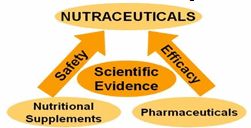 Definitions to be understood:[4- 8]
Definitions to be understood:[4- 8]
Several terms need to be defined in order to gain an understanding of nutraceuticals.
Functional food: A functional food is similar in appearance to, or maybe, a conventional food that is consumed as part of a usual diet, and is demonstrated to have physiological benefits and/or reduce the risk of chronic disease beyond basic nutritional functions, i.e. they contain bioactive compound.
Bioactive compounds: These are the naturally occurring chemical compounds contained in, or derived from, a plant, animal or marine source, that exert the desired health/wellness benefit
(e.g. omega-3 fatty acids in flax or fish oils and beta-glucans from oats and barley).
Natural Health Products: Natural Health Products (NHPs) includes homeopathic preparations; substances used in traditional medicines; minerals or trace elements; vitamins; amino acid; essential fatty acids; or other botanical, or animal or microorganism derived substances. These products are generally sold in medicinal or “dosage” form to diagnose, treat, or prevent disease; restore or correct function; or to maintain or promote health. As a product group, NHPs include nutraceuticals.
Nutrient: A feed constituent in a form and at a level that will help support the life of an animal. The chief classes of feed nutrients are proteins, fats, carbohydrates, minerals and vitamins.
Feed: Edible materials which are consumed by animals and contribute energy and/or nutrients to the animal’s diet.
Food: As defined by the Food, Drug and Cosmetic Act (1968), “an article that provides taste, aroma or nutritive value. Food and Drug Administration (FDA) considers food as ‘generally recognized as safe’ (GRAS).”
Drug: As defined by AAFCO (1996), “a substance intended for use in the diagnosis, cure, mitigation, treatment or prevention of disease in man or other animals. A substance other than food intended to affect the structure or any function of the body of man or other animals.”
Dietary Supplement: As defined by the Dietary Supplement Health and Education Act (DSHEA, 1994), “A product that contains one or more of the following dietary ingredients: vitamin, mineral, herb, or other botanical, and amino acid (protein). Includes any possible component of the diet as well as concentrates, constituents, extracts or metabolites of these compounds.”
Nutraceutical: As commonly defined by the dietary supplement industry, “any nontoxic food component that has scientifically proven health benefits, including disease treatment and prevention.”
Classification:
Categories of nutraceuticals[9- 11]
1. Nutrients – substances with established nutritional value.
Examples: vitamins, minerals, amino acids, fatty acids, polysaccharides, etc.
2. Herbals or botanical – Products of herbs of botanical products in the form of concentrates or extracts.
Examples: Aloe vera, wheat grass, ginger, garlic, etc.
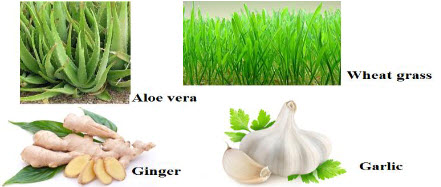
Fig.2: Herbals for nutraceuticals[6]
3. Dietary supplements – Compounds derived from other sources serving specific functions such as sports nutrition, weight loss supplements and meal replacements.
Depending upon various characteristics, nutraceuticals can be classified into[12]-
a. Nutraceuticals according to food source.
b. Nutraceuticals according to their action of mechanism.
c. Nutraceuticals according to their chemical nature.
d. Nutraceuticals according to their higher contents in specific food items.
Nutraceuticals are categorized on the basis of foods available in the market [13, 14]-
1. Traditional nutraceuticals
2. Non-traditional nutraceuticals
1. Traditional nutraceuticals:
These are natural substances with no changes to the foodstuff.They are grouped on the basis of
I. Chemical Constituents
a) Nutrients
b) Herbals
c) Phytochemicals
II. Probiotic Microorganisms
III. Nutraceutical Enzymes
I. Chemical Constituents
a) Nutrients:
Includes vitamins, minerals, amino acids and fatty acids with established nutritional functions. These are helpful in curing heart diseases, strokes, cataracts, osteoporosis, diabetes and cancer. Minerals found in plant, animal and dairy products are useful in osteoporosis and anaemia. Flax seed and salmon contain fatty acids; OMEGA 3-PUFAs and are potent controllers of the inflammatory process, maintenance of brain function and reduce cholesterol deposition.[12]
b) Herbals
Examples include willow bark (Salix nigra), having active component salicin, which is anti-inflammatory, analgesic, antipyretic, astringent and antiarthritic. Parsley (Petroselinum cripsum) contains flavonoids (apiol, psoralen) and is diuretic, carminative and antipyretic. Peppermint (Mentha piperita) contains menthol as an active and cures cold and flu. Lavender (Lavendulaangustifolia) contains tannin which is helpful in curing depression, hypertension, stress, cold, cough and asthma. Cranberries (Vacciniumerythrocarpum) contain proanthocyanadin and found to be useful in cancers, ulcers and urinary tract infections.
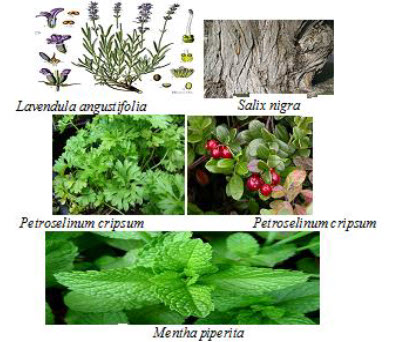
Fig.3: Traditional nutraceutical herbals[6]
c) Phytochemicals[15]
These are classified on the basis of chemical name given according to their phytochemical properties. Examples include carotenoids (isoprenoids), legumes (chickpeas and soybeans), etc. Flavonoid polyphenolics are found in berries, fruits, vegetables and legumes which are potent antioxidants, phytoestrogens, prevent breast cancer, prostate cancer, and control diabetes. Non-flavonoid polyphenolics are present in dark grapes, raisins, berries, peanuts, turmeric roots; are strong anti-inflammatory, antioxidants, anticlotting agents and reduce cholesterol.Spirulina and chlorella also used as food supplements.
II. Probiotic Microorganisms.
“Probiotcs” mean “for life” and are defines as live microorganisms, which when consumed in adequate amounts, confer a health effect on the host.
Features:
* They are friendly bacteria that promote healthy digestion and absorption of nutrients.
* They act to crowd out pathogens such as yeasts, other bacteria and viruses that may otherwise cause disease and develop a mutually advantageous symbiosis with the human gastrointestinal tract.
* They have an antimicrobial effect through modifying the microflora, preventing adhesion of pathogens to the intestinal epithelium, competing for nutrients necessary for pathogen survival, producing an antitoxin effect and reversing some of the consequences of infection on the intestinal epithelium, such as secretary changes and neutrophil migration. Probiotics can cure lactose intolerance by the production of the specific enzyme (B-galactosidase) that can hydrolyse the offending lactose into its component sugars.
Prebiotics are a more recent addition to our vocabulary and are substances which when consumed are not digested by us. Instead, they act as a nutrient source for good probiotic bacteria.[16]
III. Nutraceutical Enzymes
These enzymes are derived from microbial, plant or animal sources.
2. Non-traditional nutraceuticals
These are artificial foods prepared with the aid of biotechnology. Food samples contain bioactive components which are engineered to produce products for human wellness.
They are divided into:
a) Fortified nutraceuticals
b) Recombinant nutraceuticals
a) Fortified nutraceuticals
It constitutes fortified food from agricultural breeding or added nutrients and/or ingredients e.g. Orange juice fortified with calcium, cereals with added vitamins or minerals and flour with added folic acid. Also, milk fortified with cholecalciferol used in vitamin D deficiency. Prebiotic and probiotic fortified milk with Bifidobacterium lactis HN019 used in diarrhea, respiratory infections and severe illnesses in children. Banana fortified using soybean ferritingene in iron deficiency was discovered by Kumar.

Fig.4: Bifidobacterium lactis HN019, ‘good bacteria’ in curd and other Prebiotic and probioticfortified juices and milk[9]
b) Recombinant nutraceuticals
As the word itself denotes; these are energy providing foodstuffs formed by “recombination”, with the help of biotechnology. e.g.: bread, alcohol, fermented starch, yogurt, cheese, vinegar, etc.
Nutraceuticals are Food or Drugs?
A potential difference between a feed and a nutraceutical is that a nutraceutical is unlikely to have an established nutritive value. Feeds are required to have nutritive value and are accountable, via labeling, for these values. Another difference between a feed (food) and a nutraceutical is that feed is generally recognized as safe (GRAS).[17]
Nutraceuticals are pharmaceutical products ( pills, capsules, powders, etc) containing a concentrated form of a presumed bioactive phytochemical or zoolochemical agent from a food and used with the purpose of enhancing health in dosages that exceed those that could be obtained from normal foods. Legislature in most countries categorizes nutraceuticals as dietary supplements and therefore, regulation, is not as stringent as for drugs.[18]
Challenges and opportunities:
Due to wide acceptance the health related properties of foods are not because of single components of food stuffs, nutraceuticals has suffered a paradigm shift from the pharmaceutical model, which is based on the efficacy of single agents. Many of the bioactive phytochemicals under investigation have long been ignored, thus methods for their handling and measurement are lacking. Government regulatory bodies also face challenges in this new category of health products, which lies between food and drugs. The field of nutraceuticals and functional foods is at times confused and often lumped together with the field of biotechnology and genetic modification.[19, 20]
Global nutraceutical market:[13, 16, 20]
The last twenty years the global nutraceuticals market has shown impressive growth rates and the global nutraceuticals industry is nowadays a multi-billion dollar industry. However, the European market is lagging behind in this growth: where the global and United States market grew over 10 fold over the period 1999-2006 from $5.7 to $75.5 billion, the European market grew only 5 fold. The global nutraceuticals market is the largest and most rapidly expanding nutraceuticals market in the world with an annual growth rate of over 7%. In the United States, about two-thirds of the population takes atleast one type of nutraceutical health product. A 2001 poll by Harris Interactive (Rochester, NY, USA) revealed that 72% of those surveyed in the USA take supplements to feel better, 67% to prevent illness, 50% to live longer, 37% to build muscle and strength, 12% for weight management and 33% on the advice of a physician. Significantly, 53% said that nutraceuticals offer benefits not matched by conventional drugs but with fewer side effects. Remarkably, 95% were satisfied with supplements (Dietary Supplement Education Alliance, 2001).
Applications:
Lifestyles of human beings have changed drastically due to the industrial age, increasing work, living speed, longer work schedules and various psychological pressures which have led to an increased incidence of diabetes, obesity, various cancers and vascular diseases. The major group of nutraceuticals is endogenous in origin, being natural products responsible for eliciting activity in healthy humans. Dietary nutraceuticals may be found in specific foods and be ingested e.g., soy isoflavones, alpha lipoic acid and carotenoids to name a few. A number of plant constituents are increasingly becoming available, some individual entities e.g., resveratrol from grapes and wine and some complex combinations of constituents e.g., pycnogenol. The two glycosaminoglycans (GAGs), glucosamine and chondroitin are derived from various animal materials.[12, 18]
Treatment of joint health:
NSAIDs are used to treat osteoarthritis and rheumatoid arthritis, and more recently cyclooxygenase-2 (COX-2) inhibitors, masking the symptoms but not treating the underlying disease. Unfortunately, NSAIDS cause a wide range of gastrointestinal complications for patients.
Boswellia a tree resin used for asthma, Crohn’s disease, and osteoarthritis.
Cardiovascular health:
The two most important risk factors for coronary heart disease are total cholesterol and low density lipoprotein (LDL). Decreased arterial compliance of the arteries is thought to contribute to systolic hypertension and coronary artery insufficiency.
1. Soy products– It has been known for about 60 years that replacement of animal protein in the diet with soy protein reduces plasma lipid and lipoprotein concentrations.
2. Tea flavonoids – Both green and black tea are the leaves of Camellia sinensis. Green tea contains a number of flavonoids, particularly catechin derivatives, whereas black tea contains theaflavins and thearubigin, polymers that are formed during the fermentation process.
3. Octacosanol/ Policosanol – Octacosanol is a naturally occurring 28-carbon aliphatic alcohol found in the waxy surfaces of leaves, seeds and fruits. The major product to be investigated is policosanol, a mixture of aliphatic alcohols purified from sugarcane, whose main component is octacosanol. A number of clinical trials have studied the effect of policosanol on type II hypercholesterolemia.
4. n-3-Polyunsaturated Fatty Acids– Fish is the most important source of n-3-PUFAs. n-3-PUFAs prevent heart disease by preventing arrhythmias, generating prostanoids and leukotrienes with anti-inflammatory actions and inhibiting synthesis of cytokines and mitogens that provoke inflammation and promote plaque formation. At low doses, PUFAs provide protection against coronary heart disease and reduce the severity of cardiac arrhythmias; at high doses, they lower blood cholesterol and triglycerides, reduce platelet aggregation, have antithrombotic activity and reduce blood viscosity.
Mental Health:
1. S-Adenosyl Methionine (SAMe)– Exhibits antidepressant action. The mechanism is unclear but in clinical studies, oral administration led to increased concentration in the cerebrospinal fluid and increased levels of noradrenaline and serotonin in experimental brains.
2. Dehydroepiandrosterone (DHEA)– DHEA has demonstrated efficacy in the improvement of mood, interest, confidence and anxiety levels. It has been reported to be useful in the treatment of negative, depressive and anxiety symptoms of schizophrenia. In another trial, DHEA and its metabolites produced a positive effect on recognition memory in postmenopausal women.
3. Soy Isoflavones– The rationale for soy consumption is simply to increase concentrations of phytoestrogens, which is said to improve episodic or semantic memory.
4. Acetyl-L-Carnitine– Acetyl- L-Carnitine has been shown to cause a slowdown in the decline of cognitive measures in a number of studies conducted on subjects with mild Alzheimer’s disease or mild cognitive impairment.
5. Docosahexaenoic Acid (DHA)– DHA is widely available from fish oils and the prevalence of Alzheimer’s disease correlates negatively with fish consumption.
I. Eye Health:
1) Lutein/Zeaxanthin– Supplementation with 30mg/day of these carotenoids resulted in increased optical density of the macular pigment. It is thought that lutein is converted to zeaxanthin in the eye. These two carotenoids are present in high levels in spinach, kale, parsley and brassica.
2) Other Nutraceuticals– Pycnogenol has been suggested as a treatment for diabetic retinopathy. Pycnogenol was shown to improve capillary resistance and reduce leakages into the retina.
II. Bone Health :
1) Soy Isoflavones– These are claimed to be natural alternatives to hormonal replacement therapy. One synthetic isoflavone, ipriflavone has been shown to increase bone mass in postmenopausal women.
2) Other nutraceuticals – N-3-PUFAs and g-linolenic acid prevent loss of bone density. Also, black tea is beneficial.
III. Oral Health:
1)Tea – Tea consists of polyphenolic catechins and theaflavins. Both are known to be inhibitory and bactericidal against Streotococcus spp. They bind to surface proteins of the bacteria and induce aggregation and inhibit the enzymatic activity of glucosyl transferase.
2) Pycnogenol – Chewing gum containing 5 mg Pycnogenol produced a 50% reduction in bleeding in patients with gingival infection and no increase in plaque formation.
IV. Women’s Health :
1) Isoflavones– Soy is the most widely available source of isoflavones used therapeutically. A novel receptor, ER-b, hasapproximately seven times the affinity for isoflavones.
2) Other nutraceuticals – Supplementation with DHEA is based upon the knowledge that endogenous levels decrease with aging, particularly by 70 years. Not surprisingly, levels of all DHEA metabolites increased after supplementation with 25 mg DHEA daily; also, the neurosteroid, allopregnanolone and endorphin showed increased plasma levels and gonadotropins were significantly reduced. Research on pycnogenol has been reported to bring improvements to women suffering endometriosis, premenstrual cramps and abdominal pain after taking 30-60 mg daily.
Cancer Prevention[18]
1. Soy Isoflavones– These have weak estrogenic activity, and therefore the potential for exerting an influence on hormone-dependent cancers such as breast and prostate cancers. Their protective effect on cancer may be due to their role in lowering circulating levels of unconjugated sex hormones. Consumption of soy isoflavones has been reported to result in urinary excretion of isoflavone metabolites, whose levels have been inversely linked to the risk of breast cancer. The major soy phytoestrogens are genistein and daidzein which have been used in animal experiments for inhibition of growth of a number of cancer cell lines. It has been shown to inhibit breast and skin cancer and inhibit the formation of aberrant crypts in models of colon cancer. Genistein has been found to be a potent inhibitor of angiogenesis and metastasis, implying pleiotropic effects on inhibition of carcinogenesis and cancer cell growth.
2. Tea flavonoids – Flavonoids from both green and black teas have been found to inhibit the mutagenecity of a variety of different types of carcinogens in a dose-related fashion. Tea flavonoids have been shown to increase the rate of apoptosis of tumour cells and lead to elimination of neoplastic cell systems. Practical cancer prevention has been developed in Japan, where 10 cups of green tea are recommended daily, and green tea capsules and tablets are available. There is also evidence of synergy between green tea and a cancer preventive drug, Sulindac. Highly purified Epigallocatechin gallate is now available in formulated supplements.
The Nutraceutical Garden:
Plants offer a myriad of benefits. They provide us with not only nutritional but also medicinal benefits. The Nutraceutical Garden is divided into six components each one focusing on these different plant types. These are Vegetables, Herbs, Herbaceous Plants, Grains and Legumes, Fruit and Common Weeds.
1) Weed component–
· Burdock
· Chicory
· Horseweed
· Ground Ivy, Creeping Charlie
· Purslane
· Plaintain
· Sheep’s Sorrel
· Dandelion
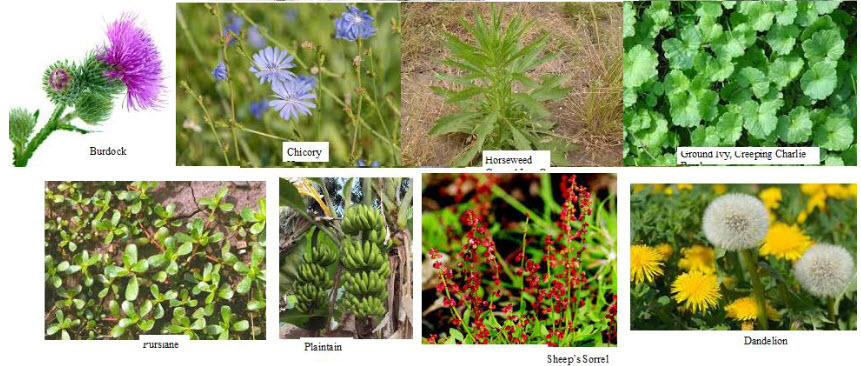
Fig.5: Weed component[12]
2) Vegetable component–
· Leek
· Onion
· Common Garlic
· Shallot
· Celery
· Parcel
· Beet
· Swiss Chard
· Mustard Green
· Kale
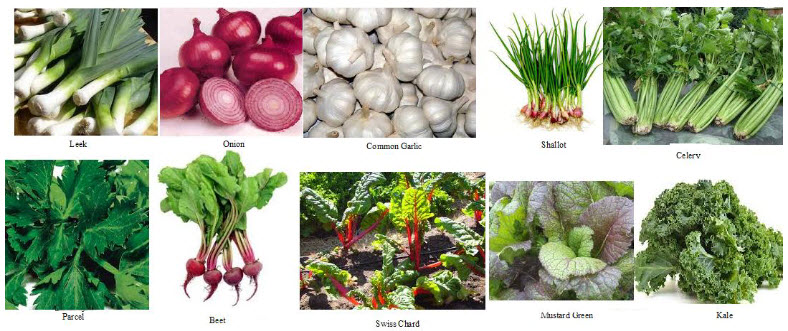
Fig.6:Vegetable component[12]
3) Herb component–
· Anise Hyssop
· Chive
· Angelica
· Feverfew
· Caraway
· Lemon Grass
· Lovage
· German Chamomile
· Basil
· Oregano

Fig.7: Herb component[12]
4) Herbaceous component–
· Common Yarrow
· Butterfly Weed
· Black Cohosh
· Foxglove
· Meadowsweet
· Sweet Potato Vine
· English Lavender
· Psyllium Indian
· Chicks and Hens

Fig.8: Herbaceous component [12]
5) Grain and Legume component–
· Wheatgrass
· Quinoa
· Barley
· Peanut
· Soybeans
· Lentils
· Hunan Winged bean

Fig.9: Grain and legume components[12]
6) Perennial Fruit component–
· Apple
· Gooseberry
· Hardy Arctic Kiwi
· Lingonberry
· Lowbush and Highbush Blueberry
· Peach
· Raspberry
· Red Currant
· Sour Cherry
· Valencia Oranga
· Wonderberry or Sunberry
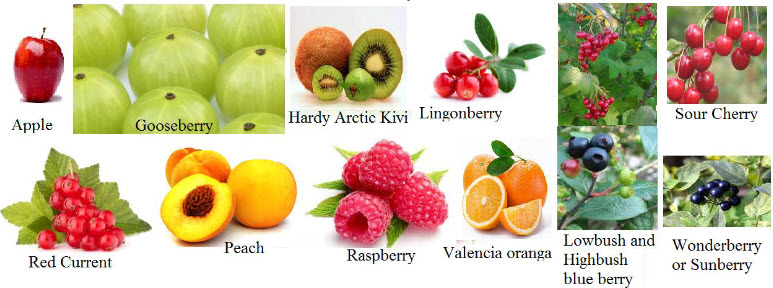
Fig.10: Perennial fruit component [12]
Adverse Effects:[15]
Reports of mild gastrointestinal side effects to more serious side effects have been reported. Problems with wide-scale use of nutraceuticals have been reported by US poison control centers.
One report of asthma exacerbation with a glucosamine/ chondroitin product has appeared. Patients taking SAMe also reported mild to moderate gastrointestinal complaints, which have been claimed to be as high as 20% incidence, but in addition there is a possible risk of more significant psychiatric and cardiovascular adverse effects. A complex relationship between melatonin and other antioxidants in vitro have been reported, in which melatonin was shown to exhibit pro-oxidant qualities, possibly due to formation of secondary oxidation products, such as endoperoxides. Levels of endogenous metabolites may be adversely affected by administration of certain nutraceuticals; glucose levels may be depressed by coenzyme Q10, and levels of thyroid hormone depressed by soy products.
Future developments for nutraceuticals:[13,17]
Nutraceuticals are destined to play an important role in future therapeutic developments and will continue to appeal the masses due to their convenience for today’s lifestyle. Increasing awareness levels about fitness and health, spread by media coverage are prompting the majority population to lead healthier lifestyles, exercise more and eat healthy.
The expanding Indian nutraceuticals market is propelling expansion in the global nutraceuticals market. The emerging nutraceuticals market seems destined to occupy the landscape in the new millennium.
- Major scientists believe that enzymes represent an exciting frontier in the nutraceutical industry. “Enzymes have been underemployed. They are going to be a hot area in the future.”
- Microbial fermentation technology shows promising potential.
- Use of nutraceuticals in sports medicine application is appealing ( Action Sports Hub {ASH} – Premier institute for future champions)
- The two major carotenoids- lutein and lycopene possess tremendous nutraceutical potential.
- Tocotrienol is promising for nutraceuticals because of its health benefits, “suggests Eileen Mourry, Business Manager for nutrition, Eostman Chemical, Kingsport, TN. “Studies show tocotrienols are powerful antioxidants. Preliminary research indicates that it might be having anticancer benefit as well.”
- Gerry McKierman sees interest growing beta glucan. “We had a lot of inquiries about our natural fermentation grade betaglucans. It is important for cholesterol reduction in soluble form and also targets colon cancer.”
CONCLUSION
Nutraceutical is growing at a rate far exceeding expansion in the food and pharmaceutical industry. Nutraceuticals are presenting excellent opportunities for research scholars and industry people to exploit their usefulness. The present accumulated knowledge about nutraceuticals represents undoubtedly a great challenge for nutritionists, physicians, food technologists and food chemists. A place for nutraceuticals in clinical research is emerging, but important pharmaceutical and clinical issues need to be addressed by further research. So, adopt nutraceuticals evidence based medicines and let food be your medicines.
REFERENCES
1. Pandey M., VermaR.K., Saraf S.A.; Nutraceuticals new era of medicine and health; Asian Journal of Pharmaceutical and Clinical Research; 2010; Vol.3 Issue 1; January-March; 11-14.
2. Ahmad M.F., Ahmad F.A., Azad Z.A., Alam M.S., Ashraf S.A.; Nutraceutical is the need of the hour; World Journal of Pharmacy and Pharmaceutical Sciences;2012; Volume 2, Issue 5; 2516-2525.
3. Rajat S., Manisha S., Singh R., Kumar S; Nutraceuticals: A review; IRJP; 2012; 3(4); 95-99.
4. Srividya A.R., Venkatesh N., Vishnuvarthan V.J.; Nutraceutical as medicine; An International of Advances in Pharmacutical Sciences; Nov-Dec 2010; Vol. 1(2); 133-145.
5. Songara R.K., Singh D.P., Gupta V.K., Kulkarni A.; Nutraceutical Products labeling: Global Issue and regulatory control; IJDFR; Nov-Dec 2010; Vol. 1(3); 167-200.
6. Rajasekaran A., Sivagnanam G., Xavier R.; Nutraceuticals as therapeutic agents: A review; Research J Pharm. and Tech.; Oct-Dec 2008; 1(4); 328-340.
7. Sakthivel L.P., Timmakondu N.K.S., Chellapan D.K., Subramaniam S.K.; Nutraceuticals and their medicinal importance; IJHAS; Apr-Jun 2012; Vol. 1, Issue 2; 47-53.
8. Lockwood B.B.; Nutraceutical supplements; Encyclopedia of Pharmaceutical Technology, Edited by James Swarbrick; Third Edition; 2431-2448.
9. Dahiya K.; Nutraceuticals and their impact on Human Health; J Plant Biochem Physiol 2013; 1(4); 1-3.
10. Kokate C.K., Purohit A.P., Gokhale S.B.; Pharmacognosy; 42nd Edition, Nirali Prakashan; 2008.
11. Singh J., Sinha S.; Classification, Regulatory Acts and applications of Nutraceuticals for Health; IJPBS; Jan-Mar 2012; Vol. 2, Issue 1; 177-187.
12. Rathore Kamal S., Nema R.K. and Mandal Sulekha,; Nutraceuticals and diabetes-an update; planta indica; October-December, 2008; Vol.4; No.4; 45-47.
13. Rajam P.R., Brij R.M.S., Sivakumar T.; Nutraceuticals: An area of tremendous scope; IJRAP; 2011; 2(2); 410-415.
14. Anita P.S., Mangesh S.T., Prasad R.V., Meera C.S.; Nutraceuticals- Global status and applications: A review; IJPCS; Jul-Sep 2012; Vol. 1(3); 817-832.
15. Silva A.D., Lanerolle P.; Nutraceuticals: Concept and controversies; CME 2011; 56; 171-173.
16. El Sohaimy S.A.; Functional foods and Nutraeuticals- Modern approach to food science; WASJ; 2012; 20(5); 691-708.
17. Dudreja H., Kaushik D., Kumar V.; Developments in nutraceuticals; Indian Journal of Pharmacology; 2003, 35; 363-372.
18. Rinaldi A.; A nutraceutical a day may keep the doctor away; EMBO; 2005; Vol. 6, No. 8; 708-711.
19. Ligade V.S., Sreedhar D., Manthan J., Pradeep M., Udupa N.; Nutraceuticals, Cosmeceuticals and Nutricosmetics: New era of health and beauty; IJHP; 2013; 50; 69-70.
20. Gupta S.K., Yadav S.K., Mali Patil S.M.; Nutraceutical- A bright scope and opportunity of Indian healthcare market; IJRDPL; June-July 2013; Vol. 2, No. 4; 478-481.
REFERENCE ID: PHARMATUTOR-ART-2352
|
PharmaTutor (Print-ISSN: 2394 - 6679; e-ISSN: 2347 - 7881) Volume 3, Issue 8 Received On: 13/03/2015; Accepted On: 06/04/2015; Published On: 01/08/2015How to cite this article: N Borkar, SS Saurabh, KS Rathore, A Pandit, KR Khandelwal; An Insight on Nutraceuticals; PharmaTutor; 2015; 3(8); 13-23 |
NOW YOU CAN ALSO PUBLISH YOUR ARTICLE ONLINE.
SUBMIT YOUR ARTICLE/PROJECT AT editor-in-chief@pharmatutor.org
Subscribe to Pharmatutor Alerts by Email
FIND OUT MORE ARTICLES AT OUR DATABASE









